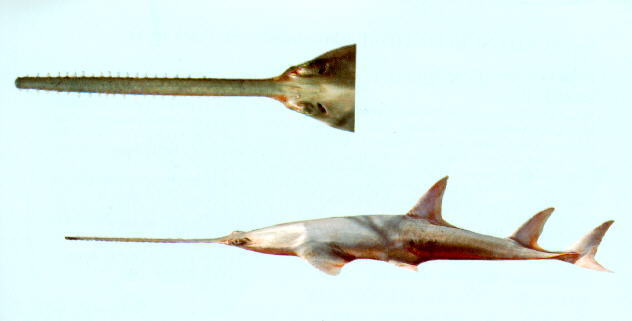| Pristidae (Sawfishes) |
| 470 cm TL (male/unsexed) |
|
benthopelagic; freshwater; brackish; marine; depth range 0 - 40 m, amphidromous |
| Indo-West Pacific: widespread, Red Sea to eastern Australia, north to Japan. |
|
Greyish above, pale below; fins usually pale. Body shark-like, pectoral fins distinct; head flattened, with a blade-like snout bearing 18-22 pairs of lateral teeth; blade slender, not tapering distally. Nostrils very narrow with small nasal flaps. Rostral teeth short, flattened, broadly triangular, lacking a groove along posterior margins; no teeth on basal quarter of blade. Adults with widely spaced denticles, young with naked skin. |
| Found inshore, often in river deltas and estuaries; penetration well up rivers needs confirmation (Ref. 9859). Common in sheltered bays with sandy bottoms. More active swimmer than other sawfishes (Ref. 114953). Feeds on small fish, cuttlefish (Ref. 9859) and small benthic invertebrates such as prawns (Ref. 114953). Ovoviviparous (Ref. 50449). Most fecund sawfish, reported to reach sexual maturity at 2-3 years (Ref. 114953). Females have litters of approximately 12 pups (Ref. 114953). Generally harmless but its saw-like snout may cause serious injury when caught: it is known thrash violently and vigorously (Ref. 9859). Caught for its flesh and liver (which is rich in oil) in some parts of Asia (Ref. 6871). Maximum lengths of up to 610 cm TL are based on unconfirmed reports (Ref. 9859). |
|
Critically Endangered (CR); Date assessed: 29 March 2022 (A2cd) Ref. (130435)
|
| harmless |
|
Source and more info: www.fishbase.org. For personal, classroom, and other internal use only. Not for publication.

